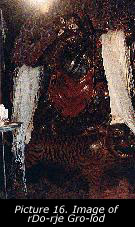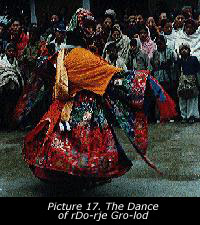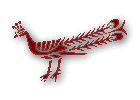|
 The Guru mTshan brgyad 'chams: Conclusion.
In my description of the dances, I have included reference to
the interpretations given of the imagery and the movements. For
example, the dance of Padma 'Byung-gnas (see above) can be said to
indicate the Guru's primordial Buddha nature, and the gestures of
his uniting the ritual implements of the vajra and bell can be
presumed to refer to the indivisibility of 'means' and 'wisdom', the
vajra and bell always carrying these connotations in VajrayAna
ritual. Even ordinary lay Tibetans are familiar with much of this
general VajrayAna symbolic language and also with many of the
stories of Guru Padma's activities and his ''eight aspects''. In
case anyone was lacking such familiarity with the mythical accounts
of Guru Padma, the monastery's visiting mkhan-po made a lengthy
speech detailing some of the stories, when the dances were
completed. However, to fully appreciate the significance of this
ritual symbolism, two further points need to be made. The Guru mTshan brgyad 'chams: Conclusion.
In my description of the dances, I have included reference to
the interpretations given of the imagery and the movements. For
example, the dance of Padma 'Byung-gnas (see above) can be said to
indicate the Guru's primordial Buddha nature, and the gestures of
his uniting the ritual implements of the vajra and bell can be
presumed to refer to the indivisibility of 'means' and 'wisdom', the
vajra and bell always carrying these connotations in VajrayAna
ritual. Even ordinary lay Tibetans are familiar with much of this
general VajrayAna symbolic language and also with many of the
stories of Guru Padma's activities and his ''eight aspects''. In
case anyone was lacking such familiarity with the mythical accounts
of Guru Padma, the monastery's visiting mkhan-po made a lengthy
speech detailing some of the stories, when the dances were
completed. However, to fully appreciate the significance of this
ritual symbolism, two further points need to be made.
 First, the ritual expressions frequently carry several levels
of interpretation simultaneously. In the specific case of the Guru
Padma dances, the ''aspects'' portrayed are associated both with
actual events in the life story of the historical Guru - sometimes
with more than one ''event'' 36 - and with some particular aspect of meditative realisation. The dance of Padma 'Byung-gnas represents
the Guru's birth, and also the awakening of primordial Buddhahood.
The various levels of interpretation add to the forcefulness of the
imagery, one level enriching another. rDo-rje Gro-lod, for example,
is associated with an incident in the Guru's life when he forcefully
subdued hostile forces in the cave of sTag-tshang (Tiger's Den) in
Bhutan.37 This event is seen as an important part of the process of his bringing the human and divine residents of the border country
between India and Tibet under his control, in preparation for his
entry into and subjugation of Tibet, such that Buddhism could be
firmly established there. rDo-rje Gro-lod is also a name received by
the Guru when he meditated and taught DAkinIs in a fearful cemetery
in Khotan known as ''Erection of Worlds'' ('Lo-ka brtsegs': Padma
bKa'i-thang Chapter 33). Moreover, he can be meditated upon as a
wrathful yi-dam deity, complete with a divine palace, maNDala and so
on. The Rewalsar monks in fact perform daily and more elaborate
monthly ritual practices, in which they envisage rDo-rje Gro-lod's
form and maNDala, and after various preparatory rituals, recite his
mantra and identify with his physical, vocal and mental expressions.
In watching rDo-rje Gro-lod's dance, knowledge of the various
mythological dimensions of his character enriches the imagery of
rDo-rje Gro-lod as an aspect of Enlightenment who can be meditated
upon to accomplish the VajrayAna transformation. First, the ritual expressions frequently carry several levels
of interpretation simultaneously. In the specific case of the Guru
Padma dances, the ''aspects'' portrayed are associated both with
actual events in the life story of the historical Guru - sometimes
with more than one ''event'' 36 - and with some particular aspect of meditative realisation. The dance of Padma 'Byung-gnas represents
the Guru's birth, and also the awakening of primordial Buddhahood.
The various levels of interpretation add to the forcefulness of the
imagery, one level enriching another. rDo-rje Gro-lod, for example,
is associated with an incident in the Guru's life when he forcefully
subdued hostile forces in the cave of sTag-tshang (Tiger's Den) in
Bhutan.37 This event is seen as an important part of the process of his bringing the human and divine residents of the border country
between India and Tibet under his control, in preparation for his
entry into and subjugation of Tibet, such that Buddhism could be
firmly established there. rDo-rje Gro-lod is also a name received by
the Guru when he meditated and taught DAkinIs in a fearful cemetery
in Khotan known as ''Erection of Worlds'' ('Lo-ka brtsegs': Padma
bKa'i-thang Chapter 33). Moreover, he can be meditated upon as a
wrathful yi-dam deity, complete with a divine palace, maNDala and so
on. The Rewalsar monks in fact perform daily and more elaborate
monthly ritual practices, in which they envisage rDo-rje Gro-lod's
form and maNDala, and after various preparatory rituals, recite his
mantra and identify with his physical, vocal and mental expressions.
In watching rDo-rje Gro-lod's dance, knowledge of the various
mythological dimensions of his character enriches the imagery of
rDo-rje Gro-lod as an aspect of Enlightenment who can be meditated
upon to accomplish the VajrayAna transformation.
[This is a preview of the full page; if you are a member of the Asiatica Association and have access to the IJTS,
please login using the box on the left menu; non members: please become a member to support the Asiatica Association, and get full access to our publications.]
|

 The Guru mTshan brgyad 'chams: Conclusion.
In my description of the dances, I have included reference to
the interpretations given of the imagery and the movements. For
example, the dance of Padma 'Byung-gnas (see above) can be said to
indicate the Guru's primordial Buddha nature, and the gestures of
his uniting the ritual implements of the vajra and bell can be
presumed to refer to the indivisibility of 'means' and 'wisdom', the
vajra and bell always carrying these connotations in VajrayAna
ritual. Even ordinary lay Tibetans are familiar with much of this
general VajrayAna symbolic language and also with many of the
stories of Guru Padma's activities and his ''eight aspects''. In
case anyone was lacking such familiarity with the mythical accounts
of Guru Padma, the monastery's visiting mkhan-po made a lengthy
speech detailing some of the stories, when the dances were
completed. However, to fully appreciate the significance of this
ritual symbolism, two further points need to be made.
The Guru mTshan brgyad 'chams: Conclusion.
In my description of the dances, I have included reference to
the interpretations given of the imagery and the movements. For
example, the dance of Padma 'Byung-gnas (see above) can be said to
indicate the Guru's primordial Buddha nature, and the gestures of
his uniting the ritual implements of the vajra and bell can be
presumed to refer to the indivisibility of 'means' and 'wisdom', the
vajra and bell always carrying these connotations in VajrayAna
ritual. Even ordinary lay Tibetans are familiar with much of this
general VajrayAna symbolic language and also with many of the
stories of Guru Padma's activities and his ''eight aspects''. In
case anyone was lacking such familiarity with the mythical accounts
of Guru Padma, the monastery's visiting mkhan-po made a lengthy
speech detailing some of the stories, when the dances were
completed. However, to fully appreciate the significance of this
ritual symbolism, two further points need to be made.
 First, the ritual expressions frequently carry several levels
of interpretation simultaneously. In the specific case of the Guru
Padma dances, the ''aspects'' portrayed are associated both with
actual events in the life story of the historical Guru - sometimes
with more than one ''event''
First, the ritual expressions frequently carry several levels
of interpretation simultaneously. In the specific case of the Guru
Padma dances, the ''aspects'' portrayed are associated both with
actual events in the life story of the historical Guru - sometimes
with more than one ''event''